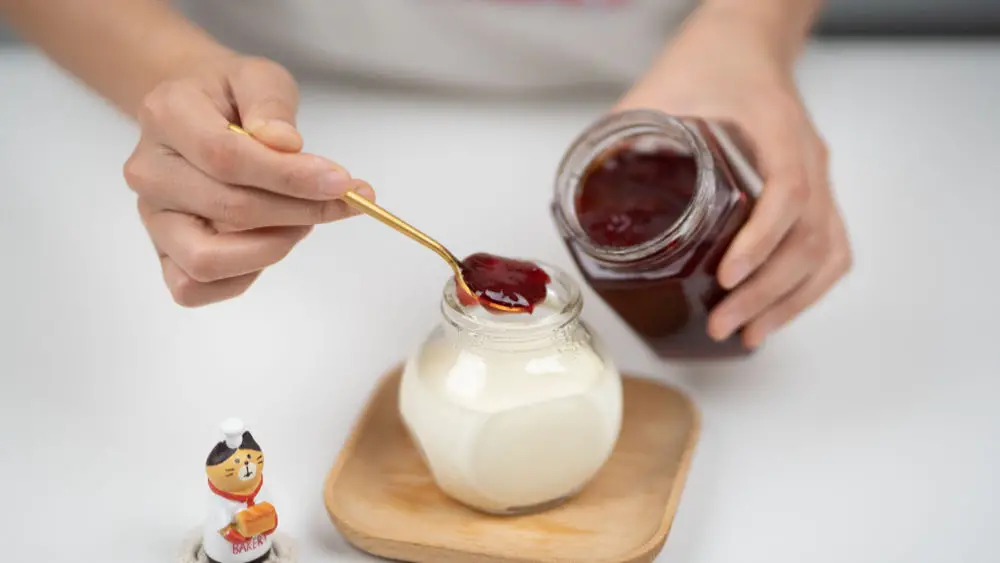If you want to start making food from scratch in the kitchen, making homemade yogurt is one of the easiest things to do. Along with making sauerkraut, it can be your first contact with fermentation in the kitchen.
Basically, all you’ve got to do is mix milk and starter together and let it incubate for a few hours and you’ve got yourself some yogurt.
Obviously that you can make it fancier but it’s as simple as that.
But before we go into that, let’s first talk about the why.
Why you need to make homemade yogurt
It’s easy to make
I do enjoy spending time in the kitchen tinkering, but you know what I also enjoy? Things that take me no time but give me great results. Yogurt is one of these things.
I have been making my own yogurt since I was in high school, through my college years and now working a full-time job. And I’ve stuck with it.
Why? The answer is simple: it’s easy.
I wouldn’t have patience to do it if I knew it’d take me a lot time to make or it’d require to be very precise otherwise I wouldn’t have yogurt. None of those things are required when you make yogurt.
Even if you don’t consider yourself a good cook, you’re able to make your own yogurt. Trust me on this.
Reduce plastic consumption

Plastic is a problem, there’s no way around it.
As regular consumers, reducing our food waste at home can be one of the easiest things to do towards being more eco-friendly but reducing our plastic intake is also helpful.
Obviously that we cannot ignore how society currently lives: everything is packaged in plastic and it’s pretty difficult to completely avoid using plastic on our day to day lives.
That being said, if you eat a lot of yogurt, you should consider making homemade yogurt because it’s such a good simple way to reduce your plastic consumption.
Let’s do some math: let’s say that every week you buy 2 4-yogurt packs, that’s 8 individual plastic cups of 120gr (4oz) in total.
8 individual plastic cups x 52 weeks = 416 plastic cups = almost 50 kg of yogurt
If you make your own yogurt, a small individual cup can be used as a starter and give you 5 batches of yogurt. To make 50kg of yogurt at home – considering one batch 1kg:
(50 kgs of yogurt * 0.2 plastic cup with yogurt) / 1kg yogurt batch = 10 individual yogurt plastic cups
10 vs 416!!!!!
That’s HUGE!
Obviously that I’m not considering the milk bottle which usually comes in plastic but still if we consider that each bottle comes in 1L bottle it’d be:
10 individual yogurt plastic cups + 50 1L bottles = 60 packages of plastic
And this is just a small example, I for one, in certain times of my life, ate more than 1kg of yogurt per week.
By making your own yogurt at home, you can reduce the amount of plastic that you consume and you know exactly what you added to the yogurt, which brings me to my next point.
No hidden ingredients and according to your tastes

Store-bought yogurt has several addictives. There are stabilizers, sugar and other additives mixed in.
“But Catherine, don’t you say to use a regular yogurt as my starter? Wouldn’t that have those additives?”
Yes, I hear you.
Here’s how I view it: if you’re adding such a small portion of starter, it’d be better than eating the whole yogurt with additives.
I’m okay with that and I think you should be too. That being said you can use plain yogurt as your starter which will have less additives mixed in.
Making homemade yogurt gives you control over the ingredients that you want.
Change the sweetness level or the type of sugar, add fruit or seeds, it’s your choice.
This is not to say that your yogurts need to be 100% “healthy”.
I do enjoy putting granulated sugar in my yogurts and I’m not sorry about it.
Cheap to make
One other thing to note is that making your own yogurt is cheaper especially if you want to start making your own flavored yogurt.
Although making plain homemade yogurt at home is still cheaper than buying yogurt, you’ll see the bigger differences when you go to flavored yogurt.
And if you only consume lactose-free products, let me tell you: lactose-free yogurts are expensive and if you make yogurt at home you’ll save a lot of money.
I’m all for recipes that end up being cheaper in the long run.

It’s fun and delicious!
Once you start making your own homemade yogurt, you’re quickly going to want to experiment with different flavors. Making up recipes with flavors that you’ve seen in the grocery store is fun.
If you have kids, you can turn making yogurt as a family activity for them to see how the science works.
Plus, it’s delicious and I get to say that I’ve made it myself.
How To Make Homemade Yogurt
And now that you’re curious about making yogurt at home, check out the following posts for the basics that you need.
How To Make Greek Yogurt
After making homemade yogurt, you can try your hand at greek yogurt which is basically strained yogurt.
How To Use Your Homemade Yogurt

So you’ve started making yogurt at home, but how do you use it?
First of all, you can use however you use it now when eating commercial yogurt.
You can eat it:
- Plain
- With granola
- With fruit
- With seeds/nuts
You can also make overnight oats with yogurt as well.
Or if you prefer to use it for your cooking, you can make delicious sauces with it. The tanginess of the yogurt is awesome to brighten up dishes.
You can also use it for baking, yogurt provides that moist texture to baking goods.
Use it as a substitute for buttermilk when making pancakes or make naan or any other bread with this yogurt.
